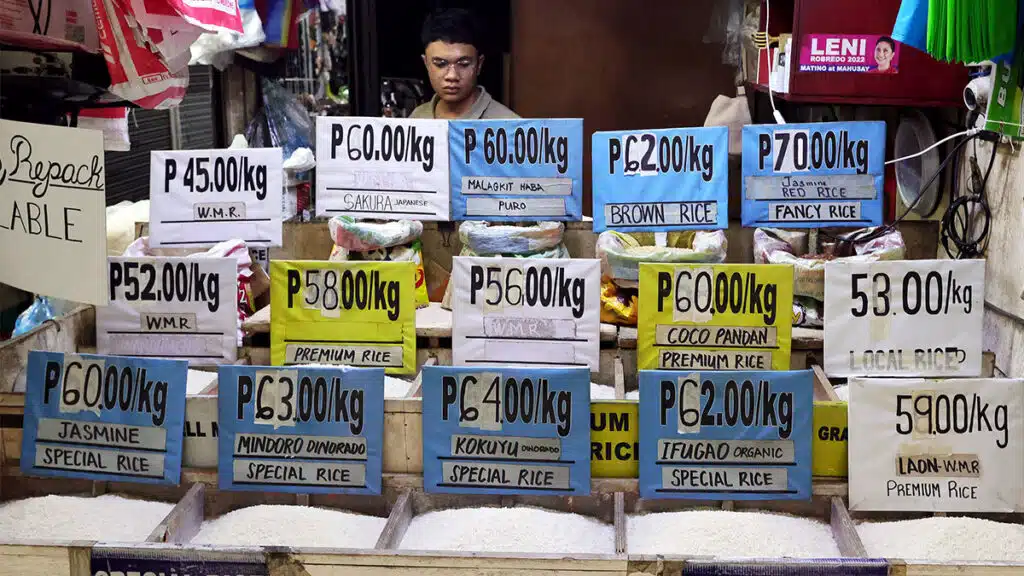Tags
Only 4% of Filipinos think Marcos able to lower rice prices – Pulse Asia

PRICEWATCH Rice prices in this stall at the Marikina City public market on Feb. 15 range from P45 a kilo, the cheapest variety of well-milled rice, to P70 a kilo for the “fancy” red rice. Keeping food, especially rice, affordable to ordinary wage earners is among the major challenges faced by the Marcos administration. —GRIG C. MONTEGRANDE
MANILA, Philippines — Only 4 percent of Filipinos believe that President Ferdinand Marcos Jr.’s administration was able to fulfill a key promise made during the 2022 election campaign season — bringing down prices of rice.
Polling firm Pulse Asia said in its report released on Friday — less than two weeks before Marcos delivers his third State of the Nation Address — that they asked 2,400 Filipino adults if the administration’s promises have already been fulfilled.
With regards to the goal of bringing down rice prices to just P20 per kilogram, only four percent of respondents said the administration succeeded.
On the other side, 32 percent of respondents said the Marcos administration was able to strengthen tourism; 26 percent said that the infrastructure program was sustained; 24 percent said that the country’s sovereignty was defended; 21 percent said food production increased; and 19 percent said various renewable sources of energy were built.
“According to 32% of Filipino adults, the current dispensation has succeeded in fulfilling its promise to strengthen tourism in the country. Around a quarter of adults identify either improving the country’s infrastructure (26%) or defending national sovereignty (24%) as one of the promises the administration has accomplished,” Pulse Asia said in their survey report.
“Only 4% of Filipinos are of the view that the national administration has achieved its goal of reducing the price of rice to P20 per kilo,” it added.
In April 2022, then-candidate Marcos vowed to bring down the price of rice if he wins the elections, noting that there have been plans to bring down the price of rice by P20 to P30 per kilogram, by recommending a price cap on the staple.
But instead of a price decrease, Marcos’ first year in office was met with high market prices of basic goods like vegetables and onion, which some lawmakers attributed to hoarding, which created an artificial shortage.
Despite these, the administration has not given up on the goal of bringing rice to P20 per kilogram, with key allies like House of Representatives Speaker Ferdinand Martin Romualdez trying to find ways to lower prices.
Last April 30, Romualdez said rice prices could go down by as much as P15 per kilogram — placing it on the P30 per kilogram mark — if Rice Tariffication Law (RTL) amendments are passed by Congress and signed into law. The House approved the proposed amendments, but a counterpart bill in the Senate did not get past the committee level.
However, Romualdez believes amending the RTL would not be a sole solution to the high rice prices, as other measures — like the lowering of tariff on imported rice — can be implemented.
Sona awareness
Aside from promises made by the administration, Pulse Asia also asked respondents if they were aware that Marcos will deliver his third Sona on July 22. According to the firm’s report, 69 percent said they were aware, while 31 percent said they were not.
Over half of the respondents — 57 percent — want Marcos to discuss in his Sona the government’s methods to control inflation.
“Just as inflation is the only majority urgent national concern, it is also the only one cited by most Filipinos (57%) as the issue they would like the President to discuss or mention in his next Sona, This view is shared by bare to considerable majorities in all geographic areas (51% to 63%) as well as Classes D and E (58% to 66%),” Pulse Asia said.
“Those in Class ABC would most like the President to talk about measures to control inflation (43%), the state of the national economy and how to improve it (41%), actions to be taken by the Philippines to stop the incursion of other countries into Philippine national territory in the West Philippine Sea (35%), and job creation initiatives (34%),” it added.
Pulse Asia said in the earlier part of their report that controlling inflation remains the top concern for Filipinos, with 72 percent of Filipinos feeling that it should be immediately addressed by the administration.
Controlling inflation was also the top concern across all locals and financial classes — 67 percent of National Capital Region (NCR) residents considered it as a top issue, along with 74 percent of respondents from Balance Luzon, 66 percent from Visayas, and 77 percent from Mindanao.
Controlling inflation has been a major concern for Pulse Asia respondents since June 2023, when a similar survey showed 63 percent of Filipinos marking it a pressing issue. The numbers jumped to 74 percent in September 2023, and it has remained at the 70 percent-mark ever since — 72 percent in December 2023, 70 percent in March 2024, and the 72 percent mark this June.
According to Pulse Asia, the interviews for the survey were conducted from June 17 to 24, 2024 — a month before the Sona — using face-to-face interviews of Filipino adults aged 18 years and above.
https://business.inquirer.net/468380/only-4-of-filipinos-think-marcos-able-to-lower-rice-prices-pulse-asiaPublished Date: July 12, 2024






